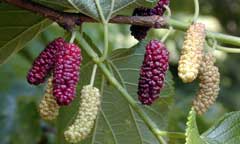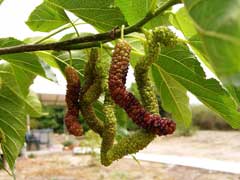 |
|
picasaweb.google.com/lh/photo/DB2aos1oSjkC1S3yqQseSQ |
 |
| http://commons.wikimedia.org/wiki/User:Yelod |
Translate this page:
Summary
Physical Characteristics

 Morus macroura is a deciduous Tree growing to 10 m (32ft 10in).
Morus macroura is a deciduous Tree growing to 10 m (32ft 10in).
See above for USDA hardiness. It is hardy to UK zone 8. It is in flower from April to May, and the seeds ripen from July to August. The species is monoecious (individual flowers are either male or female, but both sexes can be found on the same plant).
Suitable for: light (sandy), medium (loamy) and heavy (clay) soils and prefers well-drained soil. Suitable pH: mildly acid, neutral and basic (mildly alkaline) soils. It can grow in semi-shade (light woodland) or no shade. It prefers moist soil.
UK Hardiness Map
US Hardiness Map
Synonyms
M. cuspidata. Wallich. M. laevigata. Wallich.
Plant Habitats
Woodland Garden Canopy; Secondary; Sunny Edge;
Edible Uses
Edible Parts: Fruit
Edible Uses:
Fruit - raw or cooked. Dry and insipid[146]. Sweetish [183] when fully ripe[158, 272]. The yellowish-white fruit is 6 - 12cm long[266].
References More on Edible Uses
Medicinal Uses
Plants For A Future can not take any responsibility for any adverse effects from the use of plants. Always seek advice from a professional before using a plant medicinally.
Astringent
The juice of the bark is applied to cuts and wounds[272].
References More on Medicinal Uses
The Bookshop: Edible Plant Books
Our Latest books on Perennial Plants For Food Forests and Permaculture Gardens in paperback or digital formats.

Edible Tropical Plants
Food Forest Plants for Hotter Conditions: 250+ Plants For Tropical Food Forests & Permaculture Gardens.
More

Edible Temperate Plants
Plants for Your Food Forest: 500 Plants for Temperate Food Forests & Permaculture Gardens.
More

More Books
PFAF have eight books available in paperback and digital formats. Browse the shop for more information.
Shop Now
Other Uses
Dye Fibre Wood
The plant is used for paper making[266]. No further details are given, but it is almost certainly the bark that is used as the source of fibre[K]. A colour is distilled from the wood and leaves[266]. Wood - hard, close grained with a beautiful lustre. Used for furniture, construction etc[146, 272].
Special Uses
References More on Other Uses
Cultivation details
Prefers a warm well-drained loamy soil in a sunny position[1, 11]. Not very hardy in the colder parts of Britain, it tolerates temperatures down to between -5 and -10°c[200]. Mulberries have brittle roots and so need to be handled with care when planting them out[238]. Any pruning should only be carried out in the winter when the plant is fully dormant because mulberries bleed badly when cut[238]. Ideally prune only badly placed branches and dead wood[238]. Plants in this genus are notably resistant to honey fungus[200].
References Carbon Farming Information and Carbon Sequestration Information
Temperature Converter
Type a value in the Celsius field to convert the value to Fahrenheit:
Fahrenheit:
The PFAF Bookshop
Plants For A Future have a number of books available in paperback and digital form. Book titles include Edible Plants, Edible Perennials, Edible Trees,Edible Shrubs, Woodland Gardening, and Temperate Food Forest Plants. Our new book is Food Forest Plants For Hotter Conditions (Tropical and Sub-Tropical).
Shop Now
Plant Propagation
The seed germinates best if given 2 - 3 months cold stratification[80, 98]. Sow the seed as soon as it is ripe if possible, otherwise in February in a cold frame. The seed usually germinates in the first spring, though it sometimes takes another 12 months. Prick out the seedlings into individual pots when they are large enough to handle and grow them on in the cold frame for their first winter. Plant them out in late spring or early summer after the last expected frosts. Cuttings of half-ripe wood, 7 - 10cm with a heel, July/August in a frame. Plant out in spring. A good percentage take, though they sometimes fail to thrive[78, 113]. Cuttings of mature wood of the current season's growth, 25 - 30cm with a heel of 2 year old wood, autumn or early spring in a cold frame or a shady bed outside[78, 113, 200]. Bury the cuttings to threequarters of their depth. Layering in autumn[200].
Other Names
If available other names are mentioned here
Native Range
TEMPERATE ASIA: China (Xizang Zizhiqu (east), Yunnan Sheng (south)) TROPICAL ASIA: Bhutan, India (Arunachal Pradesh, Assam, Himachal Pradesh, Sikkim, Uttar Pradesh), Nepal, India (Andaman and Nicobar Islands), Cambodia, Myanmar, Thailand, Indonesia (Jawa, Sumatera)
Weed Potential
Right plant wrong place. We are currently updating this section.
Please note that a plant may be invasive in one area but may not in your area so it's worth checking.
Conservation Status
IUCN Red List of Threatened Plants Status :

Growth: S = slow M = medium F = fast. Soil: L = light (sandy) M = medium H = heavy (clay). pH: A = acid N = neutral B = basic (alkaline). Shade: F = full shade S = semi-shade N = no shade. Moisture: D = dry M = Moist We = wet Wa = water.
Now available:
Food Forest Plants for Mediterranean Conditions
350+ Perennial Plants For Mediterranean and Drier Food Forests and Permaculture Gardens.
[Paperback and eBook]
This is the third in Plants For A Future's series of plant guides for food forests tailored to
specific climate zones. Following volumes on temperate and tropical ecosystems, this book focuses
on species suited to Mediterranean conditions—regions with hot, dry summers and cool, wet winters,
often facing the added challenge of climate change.
Read More
Expert comment
Author
Miq.
Botanical References
109200266
Links / References
For a list of references used on this page please go here
Readers comment